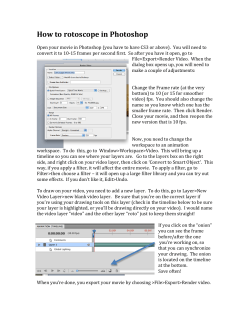
File
Adobe Photoshop Assessment Test 1. While you are editing, Photoshop recommends that you save photos in the _____ format, which stands for _____ and is the default file format for files created from scratch in Photoshop. a. PSD; Photoshop document format b. PSF; Photoshop file format c. APF; Adobe Photoshop file d. None of the above 2. Most photographers and graphic artists use the _____ when placing the focus of interest. a. Rule of 2s b. Rule of thirds c. Quadrant rule d. None of the above 3. The options bar is _____ when it is attached to the top or bottom of the screen. a. Stuck b. Liked c. Docked d. Floating 4. Selections can be the entire photo or as small a portion as _____. a. One millimeter b. One inch c. One pixel d. None of the above 5. The options bar is context sensitive, which means it _____. a. Changes as you select different tools b. Changes as you select different colors c. Changes as you select different photos d. All of the above 6. The Magic Wand Tool options bar has a _____ box that allows you to enter a value that determines the similarity or difference in the color of the selected pixels. a. Color b. Contrast c. Tolerance d. None of the above 7. By default, the History panel lists the previous _____ states. a. 5 b. 10 c. 15 d. 20 8. The Magnetic Lasso Tool options bar includes a(n) _____ check box to smooth the borders of a selection. a. Contrast b. Border c. Anti-alias d. Smooth 9. _____ softens the edges of the selection. a. Clouding b. Blurring c. Feathering d. None of the above 10. _____ is the technique photographers, designers, and artists use to create the illusion of three dimensions on a flat or two-dimensional surface. a. Layout b. Perspective c. Storyboard d. None of the above 11. On most layers, the Eraser Tool simply erases the pixels or changes them to _____, revealing the layer beneath. a. Transparent b. Black c. Grayscale d. Luminal 12. When you add a layer to an image, a new layer is created above, or on top of, the currently selected layer, creating a(n)_____. a. Layer order b. Order of precedence c. Table d. Stacking order 13. The _____ Tool erases all similarly colored pixels with one click. a. Magic Eraser b. Color Eraser c. Special Eraser d. Focal Point Eraser 14. A _____ shows or hides portions of a layer and can protect areas of the layer from inadvertent editing. a. Shape b. Locked area c. Shadow d. Mask 15. The _____ Tool reproduces portions of an image, changing the pixels in a specific area. a. Clone Stamp b. Magic Eraser c. Sampling d. Patterns 16. Double-clicking a(n) _____ button in the Gradient Editor dialog box opens the Select stop color dialog box, so you can choose a new color. a. Gradient Stop b. Opacity Stop c. Transparency Stop d. Color Stop 17. A(n) gradient style shades from the starting point to the ending point in a circular pattern. a. Normal b. Radial c. Angle d. Circular 18. If the rulers do not appear in the document window, press _____ to make them visible. a. F4 b. Insert c. CTRL+V d. CTRL+R 19. A(n) _____ does not lose its sharp lines or anti-aliasing if it is resized or reshaped. a. Vector shape b. Index object c. Gradient d. Method 20. A _____ is a gray border that appears along one or two sides of an image to create the illusion of light shining on the object. a. Blend b. Stroke c. Drop shadow d. Gradient 21. Reducing exposure to lighten an isolated area on a print is called _____. a. Sponging b. Kerning c. Dodging d. Burning 22. _____ is a change of an image’s brightness at the edges compared to the center. a. Vignetting b. Silhouetting c. Burning d. Dodging 23. A(n) _____ on the options bar allows you to specify a percentage of doging or burning. a. Lens correction box b. Saturation box c. Exposure box d. None of the above 24. You can use the _____ filter to rotate an image or fix image perspective caused by vertical or horizontal camera tilt. a. Lens Correction b. Rotate Lens c. Path d. Dodge 25. The _____ darkens areas in an image. a. Burn tool b. Dodge tool c. Patch tool d. Sponge tool 26. While there are several ways to free more RAM, the _____ command helps by eliminating the layers and Clipboard, which are memory intensive and stored in the computer’s cache. a. Purge b. Erase c. Clear d. Free RAM 27. _____ filters are used in typography, commercial art, and personal art expression. a. Stroke b. Stylize c. Artistic d. Texture 28. The _____ lets you apply filters cumulatively and apply individual filters more than once for a more intense effect. a. Filter gallery b. Filter panel c. Multi-filter d. Layered filter 29. The _____ command automatically saves only the topmost color in overlapped layers, which creates the knockout for you. a. Filter layers b. Knockout c. Save top d. Flatten layers 30. _____ means to emphasize the transitions between light and dark objects in your image. a. Sharpening b. Rendering c. Imaging d. Filtering
© Copyright 2025









